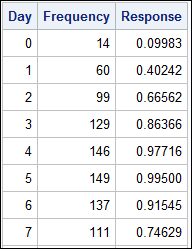All Posts

The idea of "management by walking around" has been around for a while. First brought to prominence in Tom Peters and Robert Waterman’s best-seller In Search of Excellence, the concept is that managers get out of their offices and meet employees in their work areas to get a sense of how

The Forecasting Savant Suppose you received an email from a self-proclaimed forecasting savant, advising you of a big upset in the upcoming mayoral election...and it turns out to be correct. You then get an email picking the underdog in the next championship boxing match...which is right again. Over the course

Getting universal buy in for Hadoop needn’t be an uphill struggle. In many cases, it only takes one pilot project to realize the benefits of low cost storage combined with powerful analytics. The Hadoop topic provoked passionate conversatoin at a recent roundtable discussion attended by over 25 people from a range
.@philsimon on the stickiness of data

Last year during Computer Science Education Week, some in the corporate community participated in The Hour of Code. To those who visited classrooms, thank you! Telling students about the exciting careers in computer science not only inspires leaders of tomorrow, but it also leads to more graduates equipped to innovate

I don’t know why I’m on this medical theme lately – maybe it’s because my parents are aging. They talk about bits falling off, take lots of naps and describe how body parts don’t work like they used to. They’ve gone to pre-packaged pills – dividing up their medications by
In my previous post I explained that even if your organization does not have anyone with data steward as their official job title, data stewardship plays a crucial role in data governance and data quality. Let’s assume that this has inspired you to formally make data steward an official job title. How

In trying to offer better support to SAS users, many customers’ IT departments are looking to consolidate all their SAS desktop users onto a centralized Windows, UNIX or Linux server. This option is a very practical strategy, but implementing it satisfactorily requires a lot of assessment on how the SAS

What Kind of Holidays Do You Want? Do you like your holiday filled with lots of parties or do you prefer a quiet walk in the woods with a friend? Do you love bumping elbows with thousands of shoppers at the mall or relaxing at home with family? These are good
Last time I suggested that there are some typical use cases for master data, and this week we will examine the desire for accessibility to a presumed “golden” record that represents “the single source of truth” for a specific entity. I put both of those terms in quotes because I

Congratulations if you’re one of the over 300 presenters whose proposals for content were accepted for SAS Global Forum 2015! Now that it’s time to start preparing papers, posters and presentations, I thought this would be a good opportunity to write about the Presenter Mentoring Program, an excellent service offered

Last week I discussed factors that threaten access to mental health care. However, better access to care doesn’t always mean better quality of care. Overworked mental health professionals and overcrowded ERs are forced to expend efforts and limited resources where they have the most impact. This forces compromises in care.
To perform a successful data conversion, you have to know a number of things. In this series, we have uncovered the following about our conversion: Scope of the conversion Infrastructure for the conversion Source of the conversion Target for the conversion Management for the conversion Testing and Quality Assurance for

There are many ways to multiply scalars, vectors, and matrices, but the Kronecker product (also called the direct product) is multiplication on steroids. The Kronecker product looks scary, but it is actually simple. The Kronecker product is merely a way to pack multiples of a matrix B into a block

A common scenario is where we have a table of multiple measures over time. Here we have a simple example of Frequency and Response by Day. The Response is a linear function of the Frequency, as shown in the table on the left below. The shape of the data is














